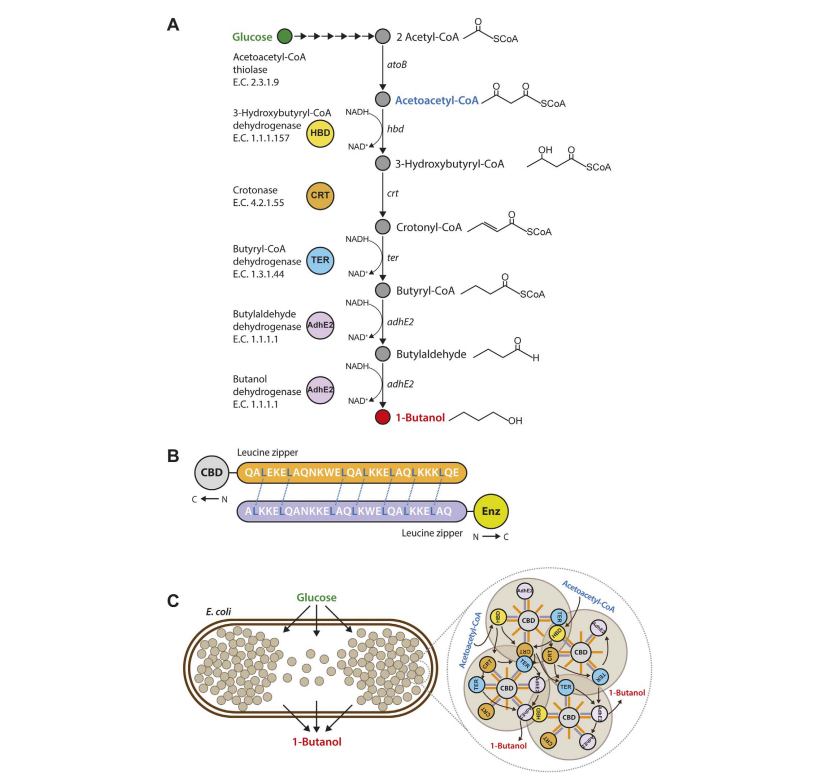Leucine zipper-mediated targeting of multi-enzyme cascade reactions to inclusion bodies in Escherichia coli for enhanced production of 1-butanol
Metabolic Engineering
 Metabolons in nature have evolved to facilitate more efficient catalysis of multistep reactions through the co-localization of functionally related enzymes to cellular organelles or membrane structures. To mimic the natural metabolon architecture, we present a novel artificial metabolon that was created by targeting multi-enzyme cascade reactions onto inclusion body (IB) in Escherichia coli. The utility of this system was examined by co-localizing four heterologous enzymes of the 1-butanol pathway onto an IB that was formed in E. coli through overexpression of the cellulose binding domain (CBD) of Cellulomonas fimi exoglucanase. To target the 1-butanol pathway enzymes to the CBD IB, we utilized a peptide-peptide interaction between leucine zipper (LZ) peptides. We genetically fused the LZ peptide to the N-termini of four heterologous genes involved in the synthetic 1-butanol pathway, whereas an antiparallel LZ peptide was fused to the CBD gene. The in vivo activity of the CBD IB-based metabolon was examined through the determination of 1-butanol synthesis using E. coli transformed with two plasmids containing the LZ-fused CBD and LZ-fused 1-butanol pathway genes, respectively. In vivo synthesis of 1-butanol using the engineered E. coli yielded 1.98g/L of 1-butanol from glucose, representing a 1.5-fold increase over that obtained from E. coli expressing the LZ-fused 1-butanol pathway genes alone. In an attempt to examine the in vitro 1-butanol productivity, we reconstituted CBD IB-based metabolon using CBD IB and individual enzymes of 1-butanol pathway. The 1-butanol productivity of in vitro reconstituted CBD IB-based metabolon using acetoacetyl-CoA as the starting material was 2.29mg/L/h, 7.9-fold higher than that obtained from metabolon-free enzymes of 1-butanol pathway. Therefore, this novel CBD-based artificial metabolon may prove useful in metabolic engineering both in vivo and in vitro for the efficient production of desired products.
Metabolons in nature have evolved to facilitate more efficient catalysis of multistep reactions through the co-localization of functionally related enzymes to cellular organelles or membrane structures. To mimic the natural metabolon architecture, we present a novel artificial metabolon that was created by targeting multi-enzyme cascade reactions onto inclusion body (IB) in Escherichia coli. The utility of this system was examined by co-localizing four heterologous enzymes of the 1-butanol pathway onto an IB that was formed in E. coli through overexpression of the cellulose binding domain (CBD) of Cellulomonas fimi exoglucanase. To target the 1-butanol pathway enzymes to the CBD IB, we utilized a peptide-peptide interaction between leucine zipper (LZ) peptides. We genetically fused the LZ peptide to the N-termini of four heterologous genes involved in the synthetic 1-butanol pathway, whereas an antiparallel LZ peptide was fused to the CBD gene. The in vivo activity of the CBD IB-based metabolon was examined through the determination of 1-butanol synthesis using E. coli transformed with two plasmids containing the LZ-fused CBD and LZ-fused 1-butanol pathway genes, respectively. In vivo synthesis of 1-butanol using the engineered E. coli yielded 1.98g/L of 1-butanol from glucose, representing a 1.5-fold increase over that obtained from E. coli expressing the LZ-fused 1-butanol pathway genes alone. In an attempt to examine the in vitro 1-butanol productivity, we reconstituted CBD IB-based metabolon using CBD IB and individual enzymes of 1-butanol pathway. The 1-butanol productivity of in vitro reconstituted CBD IB-based metabolon using acetoacetyl-CoA as the starting material was 2.29mg/L/h, 7.9-fold higher than that obtained from metabolon-free enzymes of 1-butanol pathway. Therefore, this novel CBD-based artificial metabolon may prove useful in metabolic engineering both in vivo and in vitro for the efficient production of desired products.
DOI:10.1016/nar/gkac206. IF12.012(2016y). Citation . ISSN no.1096-7176.